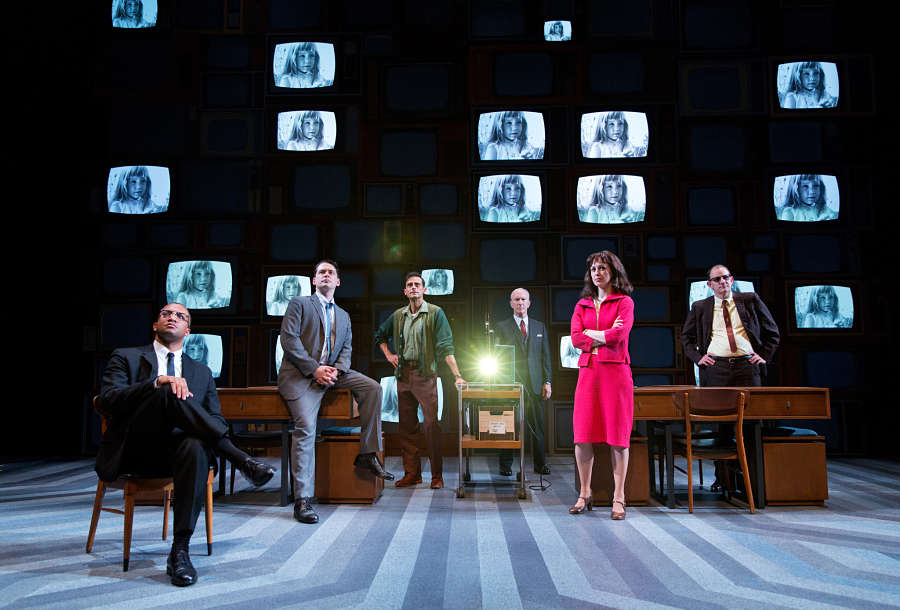A little blonde girl stands in the bushes. She’s no more than 4 years old. Probably younger. One chubby arm holds a freshly plucked daisy.
Her open, freckled face studies the flower. Birds sing as she concentrates, counting petals, pulling them off as she goes:
One . . . two . . . three . . . four . . . five . . . seven . . . six . . . six . . . eight . . . nine . . .
Suddenly, another voice. A man—amplified, accented, distorted. We can’t see him. He drowns the girl out.
He could be God.
Ten, nine, eight, seven, six . . .
The little girl looks up. The picture freezes, and we move in on her as the man counts down, closer, deeper, into her eyes, swallowing her up—
A mushroom cloud. Thunder cracks. Fire swirls. Another man speaks now. A solemn Texas drawl. A former schoolteacher. We know him.
“These are the stakes. To make a world in which all of God’s children can live, or go into the dark. We must either love each other, or we must die.”
Finally, white titles on black:
VOTE FOR PRESIDENT JOHNSON
ON NOVEMBER 3.
It’s simple and inevitable, with its own weird logic. Like a nightmare.
The men who made it called it “Peace, Little Girl,” but we know it as “Daisy.” Unless you were watching “The NBC Monday Movie” on September 7, 1964, you likely don’t know when you first saw it; the ad was only broadcast once. As it was endlessly replayed on the news and discussed in print, some Americans hailed “Daisy” as a work of art, a spectacular strike in LBJ’s campaign against Barry Goldwater, who had joked about shooting nuclear missiles into the Kremlin men’s room.
Others were horrified: It was vicious, unpresidential. Children wept in bed, and adults pondered a new world where elections wouldn’t be won on promises but on fear.
Sean Devine’s new play Daisy examines the infamous campaign ad and its long, ambiguous afterlife. Directed by John Langs, it premieres at Seattle’s A Contemporary Theatre July 8-August 7.
The play features the team at Doyle Dane Bernbach, the Madison Avenue agency that created Volkswagen’s “Think Small” and “Lemon” ads, among many legendary campaigns. But they’d never sold a politician before, and in 1964 the Democrats came to them, stumped. Johnson was polling so far ahead of Goldwater that it wasn’t enough to trumpet his accomplishments. Dems, worried that complacent voters might stay home, felt they had to create urgency.
They found the answer in Tony Schwartz, an agoraphobic sound theorist obsessed by human responses to ambient noise. Afraid to travel more than a few blocks from his apartment, Schwartz magnified his surroundings, recording and compiling an astonishing collection of sounds—streets, animals, conversation, children playing. It was, he said, “the audible expression of life.” But he realized that sound has no meaning without us; “hearing” is simply registering and classifying successive vibrations based on past experience. “Objective” sound doesn’t exist. It requires context. And it can be manipulated.
No wonder, then, that as television matured, Schwartz became an ad agency favorite. He made ads for American Airlines, Coca Cola, Chrysler, Johnson & Johnson, Kodak, and many other brands. Schwartz gave the DDB team their framework: the hypnosis of a child counting forward, the dread of a man counting backward. The explosion.

Devine, artistic director of Canada’s Horseshoes & Hand Grenades Theatre, has long been fascinated by the ad, not only as a political turning point but as a case study in how media is made and consumed. Shortly before Schwartz’s death in 2008, Devine tracked him down in New York. “I got allowed into the room that I had seen through black and white photographs hundreds of times,” he says. Devine is still in touch with Schwartz’s son, who serves as a research advisor for the play.
Devine says that though Schwartz backed Democrats, he otherwise didn’t think about the political implications of his advertising work.
“Tony would never have perceived, would never have believed, that what he created, the techniques he used, are inherently bad,” Devine says. Nor did he think “that people are being manipulated. He had this term: When the audience participates in its own manipulation, it’s not manipulation, it’s ‘partipulation.’ When people are being moved by what they already know, there’s nothing inherently wrong in that.” As the Schwartz character says in the play, “’Daisy’ is a vehicle for fear that already exists!”
Louise Brown, DDB copywriter and Devine’s protagonist, disagrees. She feels that elections should be contests of ideas, and she spends the play battling creeping regret over her role in terrifying the public. She fears that if we “navigate too far” from our principles, “we may never find our way back.” For a while, Brown is able to justify “Daisy” to herself as working for the cause of peace—until the August 1964 Gulf of Tonkin incident, when President Johnson escalated American military involvement in Vietnam. Her sense of betrayal reflects that of several Johnson administration veterans.
Brown is fictional, as is the character of Clifford Lewis, an African-American White House liaison to the DDB team. They do have historical precedents: DDB led Madison Avenue agencies in promoting women, and Lewis is based on Clifford Alexander, Johnson’s sole black counsel. But the real “Daisy” team was all white men. Devine originally wrote the play to reflect that reality, but made changes in response to playwright Valerie Sing Turner, one of Canada’s leading advocates for diverse programming. Turner didn’t inspire Devine from afar; she read the play in development and asked him to think twice. He didn’t take her suggestion kindly at first, considering his obligation was to history. But he soon realized that Turner was helping him unlock the story’s potential.
Early drafts were “more accurate, but less interesting,” Devine concedes. In part that’s because they were “less representative of the huge social complexity that was happening in 1964.” It was Mississippi’s Freedom Summer; race riots were exploding across America and women were taking on corporate positions for the first time. In this context, he felt, a play full of white men would be a dereliction of duty.

John Langs, a longtime Devine collaborator now in his first season as ACT artistic director, adds that the casting change played a role in his scheduling the play. The company, he says, “has a mandate to deal with contemporary issues and explore stories from a diverse group of voices, so it would’ve been difficult to program this had it not included a richer tapestry of an incredibly complex time.”
Devine has been studying American political history since 2003, and has worked on the play since 2008. Neither he nor Langs anticipated the “eerie similarities” to the current election. “I knew it was going to be a political season,” Langs says. “I didn’t know it was going to be this political season.” Drawing out the analogy, he notes that Daisy portrays the “presumptive Republican nominee, the outsider, the one who is shaking up the party, the one who people have great fear about. If I said just those words, I could be speaking about the Barry Goldwater campaign. Or I could be speaking to the Donald Trump campaign.”
Daisy is about more than politics, however. It also explores the unconscious that Tony Schwartz mined so well.
“We’re inviting our audience into a history of media—multimedia,” says Langs. In one scene, as Schwartz describes how the mind processes images, a back wall of video screens come together to project the first filmed image: a galloping horse.
But the audience sees the horse before the image is complete. Says Langs, “We’re using [Schwartz’s] principle as our guideline: ‘Let the audience be the workforce.’ We show an image to elicit a response that is already deeply programmed in an individual.”
As the sights and sounds of the 2016 campaign unfold, consider yourself part of the “workforce.” Who are you working for? You’re being manipulated, but are you always conscious of it? Daisy forces us to confront how the media draws on our secret selves, and asks if we’re safe from either one.


